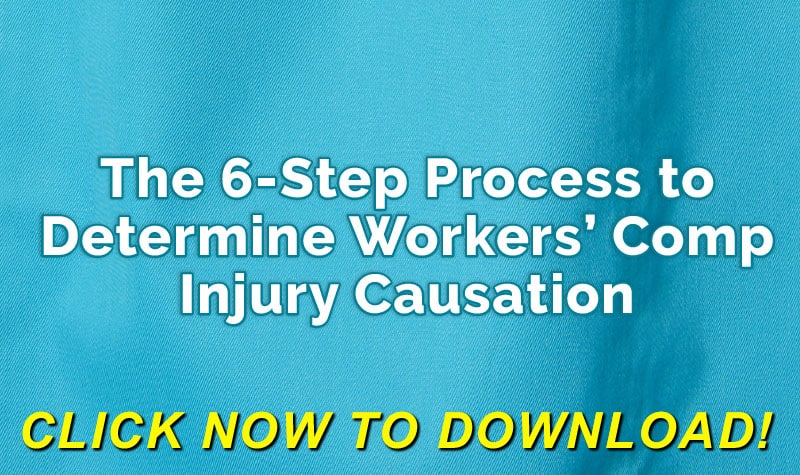
The Prescription Drug Waterfall
The wonders of modern medicine in the United States have been predicated on the proposition that pain relief improves functional capacity and gets an injured employee back to work quickly. Unfortunately, this proactive led to the overuse and abuse of opioid-based pain medication that merely masked the underlying problem and resulted in the untimely deaths of thousands of Americans. The use of prescription drugs also results in the “waterfall effect” driven by prescription medications.
Click Link to Access Free PDF Download
“The 6-Step Process To Determine Workers’ Comp Injury Causation”
- Opioids: An employee suffers from severe pain that needs to be controlled. The treating physician prescribes an opioid-based medication (even in a responsible manner) that causes drowsiness and constipation;
- Stimulant: Given the adverse side effects, the employee now seeks someone to keep them away and improves the ability of the employee to process food and liquids. A stimulant is prescribed to increase these bodily functions and keeps the employee away. They develop insomnia and have an interrupted sleep cycle;
- Non-barbiturate Hypnotic: The employee needs sleep to recover. They are now prescribed Ambien (zolpidem) assist with sleep. This may improve, but there are other unwanted side effects. Ambien is known to cause memory problems, hallucinations, and substance abuse problems.
The employee’s pain may be relieved, but additional unwanted problems result from using an opioid-based medication even in a responsible and non-addictive manner. The bottom line is the waterfall effect can create numerous unwanted problems and result in excessive money being spent to mask other medication’s side effects. Interested stakeholders should seek solutions to avoid this problem, provide all benefits the employee is entitled to receive, and avoid spending excessive money on a claim.
The Claim Handlers Tool Box to Reducing Drug Costs
There are many practical tools a claim handler can employ to avoid the waterfall effect and reduce the amount of money spent on a workers’ compensation claim. The key is to address these issues in the acute phase of the claim, right after an injury is reported, and before long-term medical management commences.
- Drug Utilization Review: This is a peer-reviewed process that looks at what is being used to treat the employee’s work injury and provides recommendations on the frequency and duration of a medication’s use. It can also be used to determine if there are more effective alternatives or cheaper generic medications that will provide relief;
- Generic Medications: Generic medications are often cheaper than name-brand medications. There are many misconceptions about generics that remain. Employees and their attorneys are often reluctant to allow a switch to be made. This is an opportunity to educate before considering litigation; and
- Pharmacy Selection: Interested stakeholders should explore alternatives to delivering prescription drug medications. The system used to price medications contains many unknown variables. A proactive claim handler should explore options and determine if such methods as a home delivery service can reduce the money spent on prescription drugs.
It is also essential to consider these opportunities in advance of settlement. The “cost” of a Medicare Set-aside is often driven by what prescription drugs someone uses at the time of settlement. The voluntary review and approval process for Medicare Set-asides requires a documented reduction in the use/frequency of a particular medication roughly six months before submission. Taking proactive steps now will reduce the projected allocation significantly in most instances.
Conclusions
Prescription drugs in workers’ compensation claims will never go away. Now is the time to address the issue and ensure it does not become an issue. It can be avoided by looking for alternatives such as pharmacogenomic testing to ensure the proper medications are being used. Other alternatives can be employed as the claim advances into the medical management portion of the cycle. Now is the time for members of the claim management team to be proactive on these issues to reduce program costs.
 Author Michael Stack, CEO Amaxx LLC. He is an expert in workers’ compensation cost containment systems and helps employers reduce their workers’ comp costs by 20% to 50%. He works as a consultant to large and mid-market clients, is a co-author of Your Ultimate Guide To Mastering Workers Comp Costs, a comprehensive step-by-step manual of cost containment strategies based on hands-on field experience, and is the founder & lead trainer of Amaxx Workers’ Comp Training Center, which offers the Certified Master of Workers’ Compensation national designation.
Author Michael Stack, CEO Amaxx LLC. He is an expert in workers’ compensation cost containment systems and helps employers reduce their workers’ comp costs by 20% to 50%. He works as a consultant to large and mid-market clients, is a co-author of Your Ultimate Guide To Mastering Workers Comp Costs, a comprehensive step-by-step manual of cost containment strategies based on hands-on field experience, and is the founder & lead trainer of Amaxx Workers’ Comp Training Center, which offers the Certified Master of Workers’ Compensation national designation.
Contact: mstack@reduceyourworkerscomp.com.
Workers’ Comp Roundup Blog: http://blog.reduceyourworkerscomp.com/
©2022 Amaxx LLC. All rights reserved under International Copyright Law.
Do not use this information without independent verification. All state laws vary. You should consult with your insurance broker, attorney, or qualified professional.







